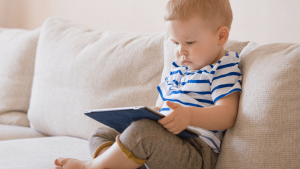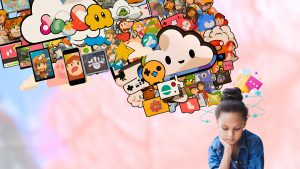
From cribs to iPotties and iPads, very young children are increasingly interacting with digital devices or are exposed to screens. Is this bad? After almost two years of pandemic life and its heavy toll on everyone’s mental health including those of young mothers – our reliance on technology is even more pervasive and ubiquitous. But what are the effects of increased early screen exposure on infants, babies, toddlers and preschoolers? What happens to the foundational cognitive, psychosocial, emotional and physical developmental needs during the critical first five years that may be challenged or enhanced by media? Children and Screens’s Ask the Experts webinar “Zero to Five: Eeny, Meeny, Mighty Tech” webinar on Wednesday, February 9th addressed these critical questions.
Kicking off a trilogy about technology’s effects across childhood’s ages and developmental stages, a fascinating conversation was held by the world’s leading experts on topics on the minds of many parents, educators, clinicians, and researchers today such as screen time, technoference, apps, games and programs, parental controls and parasocial relationships (relationships with characters). A hand-picked interdisciplinary group answered all of your burning questions about tots and tech, such as: When is the best time to start my little one on digital media?, How much media is okay? and, How do I choose the best apps for my young child? How should I be parenting my toddler at this stage?
Speakers
-
Ellen Wartella, PhD
Al Thani Professor of Communication, Professor of Psychology, Professor of Human Development and Social PolicyModerator
-
Dimitri Christakis, MD, MPH
Editor-in-Chief; Director; George Adkins Professor of Pediatrics; Adjunct Professor of Psychiatry and Adjunct Professor of Health Services
-
Courtney K. Blackwell, PhD, EdM
Research Assistant Professor, Department of Medical Social Sciences, Feinberg School of Medicine
-
Naomi Aguiar, PhD
Assistant Director of Research
-
Rachel Barr, PhD
Professor, Department of Psychology
-
Roberta Golinkoff, PhD
Unidel H. Rodney Sharp Chair and Professor, School of Education
-
Sophie Brickman
Journalist and Op-Ed Columnist; Author
[Dr. Pam Hurst-Della Pietra]: Welcome to you and nearly 1000 others who registered for today’s Ask the Experts webinar zero to five. Eeny, Meeny, Mighty Tech. I am your host, Dr. Pam Hurst-Della Pietra, the founder and president of Children And Screens, Institute of Digital Media and Child Development. Today, we are kicking off a three part series that will address what we know so far about the cognitive, psychosocial and physical effects of technology, videos, video games, television apps, etc. at different ages and developmental stages, starting with the little ones. After nearly two years of pandemic life, our youngest children have been exposed to more screen time at earlier ages than ever before. Despite our increasingly tech dependent world, the basic developmental needs of infants, toddlers and preschoolers remain the same. How can we ensure that our very young children are getting what they need most during this critical period of learning and growth? And how can we discern whether or not their screen exposure is useful or harmful? When can they be given media? What kind and how? We have assembled an outstanding group of interdisciplinary experts to offer their insights on health, play, cognition, social and parasocial relationships and early learning, and to provide you with concrete tips you can use to parent your little one wisely in our modern digital world. We appreciate all the questions you’ve submitted when you registered for today’s webinar. Our panelists have reviewed those questions and look forward to answering as many as they can in the next 90 minutes. If you have additional questions during the webinar, please type them into the Q&A box on the bottom of your screen. We’ll do our best to answer every question. We are recording today’s workshop and we’ll upload a video onto YouTube. All registrants will receive a link to our YouTube channel. Where you’ll find recordings of our past 40 webinars, which you can watch while you wait for this video to be posted. It is now my great pleasure to introduce our moderator for today’s discussion. Dr. Ellen Wartella; Dr. Wartella, is an internationally recognized scholar on the influence of media and technology on children’s health and development, has authored or coauthored twelve books in more than 200 publications, and has received various awards for her work. Among her other roles, she is currently Al-Thani professor of communication and director of the Center on Media and Human Development at Northwestern University. Welcome, Ellen.
[Dr. Ellen Wartella]: Thank you, Pam, and thank you all for joining us today. It’s exciting to be here to take part in a discussion about digital media and very young children. You know, the last several months, and last several years, actually, through the pandemic has been a very challenging time for all of us, and even more so for the parents of young children who are home, perhaps with them. I don’t know if you’ve heard the term COVID babies, but a close friend of mine is a Montessori teacher who has been talking about the changes that she’s seeing in young toddlers and young preschoolers who are coming into Montessori as a consequence of living through the last several years. So over the course of the next hour and a half, we’re going to talk about what we might know about the impact of technology and these times on infants, toddlers and young preschoolers. This is a remarkable period of growth for young children, you as young mothers of young children should know that. When you think about it physically, children go from first learning how to roll over and sit alone when they’re about six months old, to maybe standing alone and starting to walk between twelve and eighteen months to kicking a ball and throwing a ball at two years. And then finally, by between three and five, they’re running and jumping and doing everything imaginable. Not only that, but their whole physical being has changed substantially. In addition to that kind of physical development, and another major domain is cognitive development. When you think about it, the first sort of cognitive interactions that babies have is putting everything into their mouths, and that’s the way they come to learn about the world is this by eating and and tasting things. Gradually by the time they’re about a year old, they can follow simple directions and copy gestures. By the time they’re two years old, they’re playing make believe and building towards a much more interactive ability to understand. And then over the course of the years between three and five, they begin to have a much more of almost an academic understanding. They can count, they can ask questions, they can interact with people in cognitive ways and come to understand rules that they may not have been able to understand. This is a period in particular where executive functioning, the ability to follow procedures and the ability to follow recommendations of others, to be able to sit in a classroom as kindergartners, all of that is developing from the time from birth until about age five. And then there’s social emotional development, which also is important during this period. When you think about it, it’s the infants who we get so excited, as parents, when we see them smile for the first time, when they can play with others in their preschool or in their homes when they begin to play things like peekaboo. I have very distinct memories of playing peekaboo with my little boys, when they were young, and then they began to copy others and become much more independent. They show affection. They show that they have some empathy by the time they are four and five. It’s a remarkable development. Indeed, this whole period from birth to five, as I said, is remarkable. And we’re going to take time to talk about some of these issues. We’ve put together a really wonderful panel of experts who will give a presentation for a few minutes and we’ll have an opportunity to ask questions of them. So with that, I think I would like to move to our first speaker, someone who you may recognize if you’ve attended other webinars here. Dr. Dimitri Christakis, who is a member of the Advisory Board of Children and Screens, is the George Atkins professor of pediatrics at the University of Washington. He’s director of the Center for Child Health, Behavior and Development at Seattle Children’s Research Institute, and he is, as well, editor and chief of JAMA Pediatrics. Also, in addition to all of that, he’s an attending physician at the Seattle Children’s Hospital. Dimitri, please take it over.
[Dr. Dimitri Christakis]: Thanks, Ellen, and thanks everyone for joining during this difficult time. I won’t bother to say any more about myself since it’s already been said. I do want to just briefly emphasize that the mission of my laboratory is to determine modifiable factors and surely children’s early environment that can positively impact their cognitive, social, emotional and behavioral development. And to develop actionable strategies to optimize them. And so this webinar and in fact the whole use of media in early childhood is really central to my lab’s mission. In the hour and a half that I have today to talk to all of you, I’m going to touch on a few things. That was a joke. I’ll be brief and leave time for questions. I’m going to talk a little bit about screen limits, I’m going to talk about the importance of coviewing, and I think what I’ll focus the most on is digital addiction, which is some of the new work we’re doing in my lab. With respect to screen limits, I, full disclosure, I’m one of the lead authors on the American Academy of Pediatrics Media on Young Minds statement, and probably some of you are familiar with it. I just want to touch on the highlights of that and the rationale for them. So the recommendation of the academy that I endorse is that there be no screen use before eighteen months, and I want to talk about why. The simple reason is that there is no evidence based on many studies that have been done by many scientists, including members of this panel, that children acquire anything meaningful from screen use before the age of eighteen months. It doesn’t mean that they can interact with them. They surely can. You’ve probably seen your child or your toddler engage a screen of some kind in some way. But what we found is that they don’t transfer any of that knowledge to the real world. If they play, for example, a Lego assembly app on an iPad and then are given Legos, the identical Legos that are represented two dimensionally on an iPad, they start all over. They don’t transfer any of the knowledge from their interaction with the screen. So to me, what that means is that the time they’re spending on a screen isn’t well spent because we know that children need to spend time engaging the world in which they actually live. Now, beginning at about eighteen months, they can begin to meaningfully learn from screens of all kinds, and I think others will talk about interactive screens and in particular facetime or video chatting. But they do that best with parental involvement. And the same is true for two to five years. So I want to talk about two to five years, that sort of magical period where there really are a lot of excellent shows that have been shown to improve children’s, cognitive, social and emotional development. Many of us grew up with some of those landmark programs, whether it was Sesame Street or the Electric Company, and there are lots more new ones now that really have a sound evidence base behind them. They do work. They can teach children letters and numbers. They can promote prosocial behavior. We’ve done studies that have shown just that. So being selective about the programs and finding high quality ones is a really good thing that you can do. But there, too, there needs to be limits because we frequently talk about a healthy media diet and akin to a food diet. Even healthy foods in excess have untoward consequences, right? So carrots are a healthy food, but if your child eats a bushel of carrots a day, they don’t have a balanced diet because they’re probably not eating the other things that they need to eat. And if your child watches too much, even high quality preschool programing, they’re not doing the other things they need to do to develop normally; they’re not engaging in enough physical play, imaginative play, they’re not socializing enough with other children and adults. So my recommendation is that they have no more than an hour of high quality screen time. And finally, I alluded to this before coviewing with your child, particularly your younger children, is really an essential way of maximizing the benefits, such as they are. Not just so that you can engage your child in the moment and make sure they’re getting the essential messaging of the show but equally important that you can leverage those messages when the program is over, when you can revisit the show with them and reinforce the messages, whether they were letters, numbers or behaviors. And then finally, I want to talk about digital addiction, and we normally think of this as a problem affecting older children, adolescents and adults. But the truth is that I think, and I hope I can convince you, that it really begins in early childhood, and the media habits you develop with your young children are really essential to the long term development. When we think of addiction, we think of it as an interaction between nature and nurture like most things in life, and I think the problem with media is that the nurture is ubiquitous, which is to say, if your child has any predisposition to develop digital addiction, they’re very likely to be at high risk for it, if not to actually develop it because we immerse children and be in media from a very, very young age. And the reason I think infants may be at great risk is for two sorts of predispositions that they have, that they’re born wired to understand causality and what’s been called the violation of the expectation paradigm. And I’ll run through both of these quickly and then show an example. So babies are born, as Ellen alluded to, not knowing the rules of the world, and they spend an enormous amount of cognitive energy trying to figure out cause and effect. They’re constantly staring at you, at others, to figure out what makes things happen. And when they engage in sort of traditional media, even the high quality media I alluded to before, the one thing they never say or never think if they’re pre-verbal is ‘I did it’ because they don’t make anything happen, and their ability to understand cause and effect is very limited by the presentation on the screen. When I show you this baby here and I ask those of you that have parents that are parents of young children, which is most of you what this child is going to do, I suspect you’ll tell me that she’s going to throw those toys off their high chair. And when they do that, the parent is going to go pick, certainly the first time, the parent is going to go pick them up and put them back. The child is going to delight in that. It looks like that’s already happened here and she’s going to throw them off again. And the reason she’s doing that is because she’s understanding cause and effect. She’s making something happen. She is engaging her parents, making them come and do something, and she can reliably do it over and over, and she’ll keep doing that until the parent stops. Right? Because this loop is an infinite one, it’ll go on till the child is five, and eventually the parent stops bringing the toys over, at which point the child may very well have a meltdown, but the iPad doesn’t ever stop. The iPad never tires of giving the child the cause and effect feedback. And in fact, a young infant can sit there and push the iPad and make something reliably happen and keep doing it. Now, the other thing I want to talk about is the violation of the expectation paradigm. And very briefly, if you bring young toddlers into the lab and you put them in front of the puppet show like this,close the screen, open the screen and track the rise to see how long they stare, what you find is under this scenario, they stare considerably less than under this one. Why? Because I’ve totally rocked the world with this. Their understanding of object permanence has just been challenged. They don’t understand what happened. Cause and effect has been violated, and all of a sudden they need to stare very long to try to figure out how this is even possible. Now I want to show you how these are manipulated both deliberately and unconsciously with touch screens and the effects that have on very young children. So this is work we’re doing in our lab now where we bring children in and look at how difficult it is to get them to disengage. And I’ll show you sort of three conditions: one is an Elmo guitar, which is sort of an electric toy my kids played with, one is an iPad app that simulates an instrument, and the third is a highly interactive, highly unpredictable app called Pence Parade. And you’ll notice in the lab that one of my research assistants will ask the child at a very particular time, pre-specified, to return the object with which they’re engaged and watch what happens: “Can you sing a few? Give it to me. Thank you. Good job, OK, let’s clean up” OK, so that’s the Elmo’s guitar, and then this is the, it’s called the Music Sparkles, and it’s a piano app where she can, this is Nora, Nora can push and make things happen. “Here, see? Give it to me. Thank you! All done, good job.” And the final condition is, this app that’s designed, I use that word somewhat pejoratively, for young children, and you’ll note
a lot of predictable and unpredictable features. When the child touches the screen things pop out, sometimes they pop out at random, sometimes different things pop out. So, it has predictable and unpredictable features. And you can see here she’s pushing it and making things happen and unpredictable things are happening. And she pushed it and something happened that you didn’t expect. And when we look across the three conditions, what we see is there are significant differences and that these apps that are designed with these features are much more difficult for children to disengage from. And I’ll stop there and I, I think my time is more than up, so I will yield to the floor and happy to answer questions whenever that time comes. Thank you very much for your attention.
[Dr. Ellen Wartella]: Thank you, Dimitri. I just have one question and maybe you’ve already answered it, but just a quick note. You seemed to imply that there’s a major difference between an hour of interactive screen time apps and leapfrogs and an hour of TV screen time, like watching Sesame Street. Is that the case or? Give me a short, quick answer to that.
[Dr. Dimitri Christakis]: Well, you know, it’s a really good question. So like, I mean, what we know about cognition and young, really at all ages, is that engagement and reiteration is what drives learning, and so no, I don’t think that there’s a difference. I think it’s the salient features are different, but the experience is what matters. And I think what I’m trying to convey is that there are many ways the child can be engaged. They can be engaged just because of the formal features like they are with Pegs Parade, they can be engaged because a parent is in the room making sure that they’re getting the essential message and they can be engaged just because Elmo is a very compelling character who conveys to them things that they need to learn. So, no, it’s not it’s not a unique feature of the platform. I think it’s the whole experience.
[Dr. Ellen Wartella]: Thank you, Dimitri. Well, we’re going to move on now to talk with Dr. Rachel Barr, who is a professor of psychology at Georgetown University and director of the Georgetown Early Learning Project. Rachel is primarily interested in how young children pick up information rapidly from the world around them and how children bridge the gap between what they learn from media and applying it to the real world. It’s nice to see you, Rachel.
[Dr. Rachel Barr]: Nice to see you as well, and thank you, everyone for joining. Um, ironically, I’m going to talk about something that all of us have become very familiar with during the pandemic, which is video chat. And video chat has been around since 2003, and it was first actually developed by the military and has been extensively used by deployed families to remain connected. And so what I want to tell and talk to you about since we now have had quite a few years of looking at young children and video chat is what we know about emotional learning from video chat and also learning and transfer from the internet. And social contingency is the magic ingredient. In 2015, we asked parents “why do you use video chat?” and this might be obvious to many of us now that we use video chat to see and communicate with people who are far away. And hopefully what I’ll convey in some short images and videos is the creativity of babies and families in this digital play. But first, let me just go over a little quick research. First of all, do we know if infants can respond to people that they know in video chats? And so what Alex McClure did is she bought a baby and a caregiver into a room and is that a little screen here? And she had a mother in a video chat in a video, and it was a live contingent video chat. And you can see the mother here from the right in video chat, and then we had mothers be live in the room. And we compared to how babies responded, and they were playing peekaboo. And what we found is that babies as young as six months responded to people that they knew via video chat. Video chat is an exception to that AAP under 18 months rule. And there’s what the baby said is that they decreased their heart rate, which means that they were engaged during video chat just as they were in live interactions. They enjoyed playing peekaboo over the video chat just as in real life. And one thing that mothers did was that at the beginning of the videochat, they took a slight pause and they said, “Hi baby, how are you?” And those mothers that took this like pause to let the baby get used to them being on video chat, those babies smiled and interacted more. And so not only can they connect via video chat to other people that they know they can also learn more easily, and these are just a sample of some findings that I’ll tell you about. So Myers and her colleagues set up an experiment where they had a new person, someone that the child didn’t know, video chat with a child three times over a week, and these are one to two year olds, and she had them play games with words. And then she brought them into the lab, too, in real life. And by eighteen months, after just three video chats, the age eighteen months old, could recognize the person; they also imitated more from video chat than the group who’d been exposed to pre recorded video, so suggesting they could learn easier from video chat and videos. By two years, they were also able to gain more new words from video chat and videos. And another group looked to see about this emotional connection, and they found that a video chat interaction having a live video chat played in a room calmed a baby down, a two year old down, and this did not appear when the baby could only have a phone and hear the parent. So, the video chat, seeing and hearing the video chat, calmed the baby down. By two and a half they could play hide and seek via video chat, not by video. And by four years, they could actually understand storybooks by video chat just as well as live interaction, as well. So, they can definitely learn a number of these different games by video chat. And we were particularly interested in this because we wanted to know about, particularly during COVID, about when our relationship and how grandparents and the grandchildren were staying connected and whether or not they could stay connected via video chat during this time of social isolation. So we collaborated a number of us on this project and we invited grandparents and parents of children zero to five to complete a survey about video chat use between June and August 2020. And what we found is, perhaps not surprisingly, that most of these grandparents were video chatting with their grandchildren, and about 50% of them were doing this either every day or a few times a week. And importantly, as the baby got older, so did the video chat length. And these grandparents and parents were very creative and engaged in all these behaviors, so peekaboo, hide and seek, funny faces, things that we just talked about the baby understanding and learning, being able to learn from videochat imitation. And not only that, it had an important impact on grandparents and parents as well. The more often that these parents and grandparents reported video chatting, the greater the variety of digital play they had on video chat, the more the grandparents felt that they were closer to their grandchild and then more the that the parents actually enjoyed those interactions as well. So this has a lot of implications for many different families who are separated not only because of the pandemic, but because of deployment, employment, incarceration, divorce or migration. But we really wanted to know what was it that these babies and grandparents were doing, so we actually asked families if we could video these video chats. It’s very meta. And we did this before the pandemic and also during the pandemic and with different groups of families. And what we found is that we need to keep the video chat short and frequent, that children make up for loss of physical contact, that children and families share really exciting things across the screen, like this space shuttle and animals. And that pretty, and the important thing is they’re very good at this back and forth sharing of information. And finally, that relationships really matter, this back and forth that the baby was the happiest, the more sensitive and engaged the grandparent was. And the key thing about this is we had in-person and we had video chats, and it was the engagement and the connection, not the platform that was important. So, back to a key premise of early child development, what matters? Just like in real estate, in infancy, its relationships, relationships, relationships. And I wanted to finish, hopefully this will play out properly by sharing actually what parents and grandparents did. This was done in collaboration with the AARP. And these are the grandparents and parents showing how to play via video chat. [Video children and grandparents on video chat plays] Okay, and you can find this video at, on the AARP site, and I’ll put it, and hopefully we can put it into the Q&A.
[Dr. Ellen Wartella]: I have one quick question. Do you have any time limitations around video chatting?
[Dr. Rachel Barr]: So I think the thing that we’ve learned from families is that over the past four years is really that short and frequent is really good. So, otherwise, it can be really hard for the parent who’s sort of hosting video chat and it can be hard for the baby, it can be hard for the other person on the other side of the screen. So on average, as we’re about 18 minutes, but they went from two minutes to 25 minutes and it just sort of just gauging, you know, follow the lead of the baby and follow the lead of the family. And one other tip that we were going to suggest was plan for these events. If we can plan for a video chat that knows that day mornings might be great, or actually it would be really great just before bedtime if you could come on and read a book to the baby, that would be really helpful to me. So plan and plan for short, plan for frequent and the babies will learn very quickly about the other person and play, probably.
[Dr. Ellen Wartella]: Thank you. Thank you. Thank you, Rachel. Terrific. So our next panelist is Dr. Roberta Golinkoff. Who is the Unitel Rodney Sharp Chair and professor of education at the University of Delaware. She’s also the founder and director of the Child’s Play Learning and Development Lab. Dr. Golinkoff is known for research on language development, the benefits of playful learning, the effects of media on children and early spatial development.
[Dr. Roberta Golinkoff]: Thanks, Ellen. Can you guys see my talk?
[Dr. Ellen Wartella]: We can, yes.
[Dr. Roberta Golinkoff]: OK, great. I’m going to make it just a little bigger and I’m going to thank the panelists who came before me because I really enjoyed learning about their research. I’ve done a lot of research in this area as well. And I’m so happy to be able to share my talk with you today and be among such distinguished people. So I called mine, “Really? My Baby Needs an iPad?” Are you skeptical, I’m speaking to people in the audience, about what babies can get out of apps? Well, here’s one. It says it’s not difficult for me to learn numbers, letters and tones. What’s the deal with tones? What does that do for one’s life? And here is a Fisher-Price app that they are marketing for children called Laugh and Learn Smart Stages tablet. And I want to point out that this is for children from twelve to thirty-six months. I’d like to note that these are being sold to babies that can’t walk yet. I think the idea is that children see parents on their devices so often that they want to be parental like too, but, we’ll see. This is my favorite, after all, we all multitask, I think the idea is to keep them on long enough and something might happen. Talk about causality, as Dimitri did. They will not be quite sure what is happening when they are involved with something on this screen. Let’s take a true false test, some of the answers have already been given. OK, children under two learn just as well from screens as they do from real life interaction. Was that true or false? Think about it. Those in the audience. Two, young children do not learn much from Sesame Street. We’ve already talked about Sesame Street, so many people will know what is true. Three, the more time spent on screens between twenty-four and thirty-six months, the better children did on developmental tests at sixty months. True or false? Mothers of six month old whose babies watch screens for three hours a day do so because of maternal stress. If you can imagine that three hours a day for six months old, I have to pause there. The quality of the apps for young children is regulated and very good. All right. Let’s see. You’re going to find out how many you got right. The first is children under two learn just as well from screens. That’s false, and we have shown that. Now, what Rachel Barr talked about was the fact that when the interaction is contingent, that is when it’s responsive and there’s a back and forth, then children can learn from screens, but not from passive screens. Two, young children do not learn much from Sesame Street that’s already been discussed. You know, that’s false. Kids do learn from Sesame Street. I personally love it. The more time spent on screens between twenty-four and thirty-six months, the better kids do. That is not true. That is not true. Mothers of six month old whose babies watch screens for three hours a day do so because of maternal stress. That’s false. It seems that the amount of time mothers put children in front of screens is related to their education level. The lower their education level, the more they put their children on screens. The quality of the apps for young children is regulated and very good. I think the majority of people on this call are fully aware that that has to be false because they haven’t been able to find any organization that will help them make these determinations. So let’s dig in on the last one about regulation. So what about the quality of the apps that are available to young children? When I and my colleagues entered the fray to work on this issue, there were no scientists that had tackled this. There was no regulatory group that existed or even now to evaluate apps. Yet the majority of apps sold or given for free are for preschoolers. In 2021, this is all apps, it’s a huge number, 230 billion apps were downloaded. We are in this new world. Enter, four evidence-based principles, drawing on the science of learning for app designers, parents and educators. That’s the product of what happened after we did an analysis of the quality of apps. So based on how human brains learn best, we found that apps that include the following features are worthy of your child’s time when they’re active, not passive. So we’ll talk about these individually in a moment when they’re engaging and not distracting, when the information is meaningful and links to their lives, and when they’re socially interactive. Now, obviously, I am not talking about six month olds at this time. I am talking about preschoolers, and the pillars that we derived came from thousands of psychological studies that were all based in the science of how children learn. So what do we mean by active? We mean mindson, not just swiping. From Piaget to Vygotsky, going back to our origins in psychology, we know that things that require thinking, actual thinking make for sticky learning, operating on the material, for example, choosing a story’s ending or inserting a puzzle piece that’s active, that’s active. Engagement is when children are encouraged to remain on the task, not when the narrative stops to distract. Some free apps have ads in them that break the narrative. And some apps put in a little tasks interspersed that break the narrative. When these apps are meaningful, that is, they use real context, that doesn’t mean there’s anything wrong with fantasy, but when they connect new material to existing knowledge that the child has is when learning works best. So if you want to introduce new concepts and you do it in the context of a story about baking cookies, you know it’s very likely that they will be able to learn that information. It is also the case that children are born into a social soup, and from the beginning, interacting with people is absolutely crucial for their development. Thank you, Rachel Barr, for leading into the argument that I am making today that children look to learn from people from birth. They want high quality collaboration. And back and forth between peers and between parents and children and teachers and children is what leads to increases in learning, as Rachel told us, it’s when the responses from the other person are contingent or rest upon what I have just said or done. After we came up with these four pillars, Jenny Radesky and her students had the idea to use the four pillars to evaluate actual apps, so they looked at 100 apps that were the highest downloads from Google Play and the Apple App Store. Some were free and some charged. We all derived criteria for each of the pillars that ranged from zero, one, two and three. The lower the score, the worse the evaluation on that pillar. So what did they find? This is not impressive, and note that this is what our children are using. These are the 100 most frequently downloaded apps. So let’s look at Pillar One active learning. They only get a one. Children are really not being asked to think in the use of these apps. Pillar Two engagement in learning. There are interruptions and children’s engagement is not pursued in a way that we would think would be healthy for them to engage in learning. Pillar Three is meaningful learning. That would be when what is being taught on the screen or told on the screen relates to the child’s life. Again, the majority get only a one and some get a two. Social interaction well in Wave one, that’s what I call where we are now. Wave one for apps hardly required any social engagement, and if they did, it was quite minor. From the article, fully 58% of apps studied showed lower quality design when assessed against the four pillars of learning principles. This is not good. So what are parents to do? Well, look for the pillars when considering buying an app or when your child is using one. It turns out that the apps that you purchased were only a tiny bit better than the ones that were free, so that doesn’t guarantee anything if you pay for it. Keep reading books to kids. Don’t hand them tablets. Now, that’s another talk because we know how much children learn from sitting with a caring adult who follows the little pointing finger and who talks about what the child is interested in. An app can’t do that for your child. Children don’t need digital friends. They need real friends and real people. Relationships are what it’s all about. Finally, your baby does not need an iPad, she needs you and other caring and loving adults in her life so she can learn. So the challenge for the industry, the app industry, is to preserve the power of human relationships by using media as a vehicle, as a tool and not to work against social interaction.
[Dr. Ellen Wartella]: Thank you, Roberta. Thank you so much.
[Dr. Roberta Golinkoff]: Thank you.
[Dr. Ellen Wartella]: I think for the sake of getting through all of our panelists, we’re going to move right on to Courtney Blackwell. Dr. Blackwell is a research assistant professor in the Department of Medical Social Sciences at Northwestern University Feinberg School of Medicine. Her research focuses on early childhood well-being and identifying the social environmental factors that promote positive health and functioning across the lifespan. Welcome, Courtney.
[Dr. Courtney Blackwell]: Great. Thank you, Ellen. So I’m really glad I went after Rachel and Roberta, you have set me up perfectly for this talk. I’m going to talk today about whether media and technology are social hazards for kids or social helpers and thinking about how media integrates with early social development. So first, I’m not going to share specific research studies, but all of these key considerations for parents and educators are based on the research. So first, consideration relationships first; technology second, we just heard it from Roberta. So this is really just echoing that, thinking about how positive relationships can drive your technology use, and basically everything else in your life and with your children. So we know that technology use sorry, we know that relationships, are critical for children’s short and long term health and well-being. We also know that actually relationships can help even in times of adversity. So we recently completed a study during COVID, and what we found was that family engagement and the levels of social connectedness that the child had actually promoted their well-being and also was a buffer against COVID 19 related stress. So we’re really finding the relationships are key and some practical considerations here: thinking about creating a no device time. I know a lot of people already do this. So you might not have devices at meals. But one thing I think is important to think about is what are you doing then during that time? So you put your phone down, everyone puts their phone down. But are you talking with your children? Are you just sitting there eating your meal or are you really engaging with them? So it’s not just enough to say, OK, we’re not using devices, but what are you feeling that time with? And then the second consideration is thinking about placing all power chargers in the central location like a kitchen and then children have bedtime routines. So thinking about putting devices to bed every night, and that’s not just for the kids, that’s for you too, and thinking about it so that they’re not in the bedrooms, they’re not in your bedroom, they’re all going to bed and then you can go off into your bedroom routine. And so it’s just a way to foster relationships outside of technology. The second consideration is thinking really about your technologies, because it matters, and thinking about how you might reconsider how, when and why you use technology. So some recent studies have shown that technological interruptions. So maybe you’re playing with your child. Can you get a phone call or you get a text? Or, you know what? I’m going to go check my work email. He’s playing, he’s fine. Those interruptions can actually have a big impact on your parent child interactions and also on children’s behavior and their learning. And one thing that we’re starting to uncover is that it may be bidirectional. So some of you may be able to think of times when your child is misbehaving and you just wanted to withdraw from that. And so you go check your iPad, hopefully they’ll figure it out. But that makes your child more misbehaved and that makes you more stressed. And so if this bidirectional relationship and cyclical. So thinking about how we might put those technologies down for those key moments you’re with your child. Thinking about really some considerations: next time you’re looking, you’re with your child thinking about reaching for your phone, ask yourself whether it’s really necessary. Can it wait? Is it actually interrupting your engagement with your child and thinking about times where you might set aside time with your child everyday to engage in a fun activity. It could be with media if they’re over 18 months. It doesn’t have to be with media, but really here it’s thinking about putting your own technologies to the side. Not even creating a mental list is really just trying to be present with your child during that time, whether or not that engagement includes media. And then the final consideration here is consideration three, connections and creation, not just consumption. So we just saw a presentation on apps and there are some educational apps that are great for kids and have shown that kids can learn from apps from educational television shows like Sesame Street. Daniel Tiger is another one, and sometimes it’s great to have one device per child where they can have personalized learning. But it’s also important that there’s more to technology than just that. So one of the things that we’ve heard a lot about today is joint media engagement. So that’s co-using the devices together. There’s research showing that that can improve the parent child relationship, and it can also facilitate and foster sociability. Also co-engaging around the media, specifically Daniel Tiger. Some of these shows that promote social emotional learning that actually help preschoolers learn key social skills like empathy, like emotion recognition. So with and it was only when they had that parent present to help extend the learning that was happening on the screen. So there are ways that technology can be used and can be used to enhance social relationships and sociability. But we also might think beyond just the content. And so some considerations setting aside time for joint meeting engagement, it’s really important we’ve heard that, but we also know parents have a lot to do, and it’s not necessarily realistic to do that every time your child may be using the media. So thinking about times, intentionally setting aside time to say, Hey, we’re going to do this app together or we’re going to watch this TV show together, and most children’s TV shows might be eleven minutes, and so it’s really not that much time, but you can create this meaningful experience with your child. And then second, finding opportunities for sharing devices. So some of the work I did in kindergarten classrooms, we found that actually when the kids shared the device, that actually ended up increasing their literacy scores more than the kids who only use one to one devices. And a lot of this came because the kids who had to share devices had to communicate more. They had to negotiate. They were doing social problem solving. They had to figure out, OK, it’s my turn to use the iPad. It’s your turn to use the iPad. Even in preschoolers, um preschool classrooms, we had shared iPads, and the teachers had those little cards that say my turn, your turn. And so they used the device to practice sharing. So it’s something that has nothing to do with the content that’s on the technology, but you’re using that device in a novel way to help promote these social skills. We heard a lot about creating shared experiences via video chat. And so that’s just one other way to connect with distant friends and family members and make it playful. And then finally thinking about creative ways you might use the technology. So another example from the classrooms I’ve worked in, they and a lot of people think technology kind of isolates people inside. And what about playing outside of nature? So in this classroom, they went on nature walks, but they took their iPads and they went on shape hunts. And so one idea is to take your child out in nature, could be inside, with an iPad, with a phone and start looking for different objects that represent different shapes and then taking a picture of the shape. And then you might bring all that back in that digital scrapbook you have, and they can trace the shapes. You can help them identify the colors of the pictures and the shapes they saw. So it’s really a way to use the technology without focusing just on the apps or the shows, or just using it as this one to one child alone with the device. And finally, I’m taking this quote from Dr. Jenny Radesky. You don’t have to be available to your children 100% of the time. In fact, it’s healthy for them to be independent. It’s also important for parents to feel relevant at work, and other parts of their lives. I think this is huge, especially during COVID, when parents are not only parents, they are teachers, they are employees, they are parents, they are managing maybe children of different ages who have different needs and just finding a time for yourself as well. And it’s OK for the kids, for the older children to have media time. But it’s also again encouraging co-use with them. But I think it’s, we know from research that parent mental health makes a big difference for the child’s mental, physical and social health. So if the parent is too stressed, the children will have negative consequences. So really, finding the balance is what this is about and really emphasizing the relationships with your child first and finding ways to extend the media into those.Thank you.
[Dr. Ellen Wartella]: Thank you. Courtney, I have a quick question since you brought it up towards the end. Do you have any guidance for parents for how to put limits on screen media use when they have children of different ages in the household where they have a young preschool child and maybe a nine or ten year old?
[Dr. Courtney Blackwell]: I might defer to some of the others here like Dimitri, but I think it’s a challenge. Especially, one of the easiest ways to do it is to have them both have the same limits. The challenge becomes with remote learning, so it might be for the older kids that you have some time on the technology specifically for learning and with the younger kids, you might find other ways. So the older child might say, OK, you have 15 minutes on the iPad. I’m going to then use that 15 minutes with my 18 month old to play a game. So they’re actively engaged doing something and not focused on the fact that their older sibling has time on the iPad. And even if it’s short spurts, maybe you give your younger child two minutes on the iPad and say, OK, you can use it and share it. The other option is having the older kid teach the younger kid to have a co-use, which works really well to have them kind of navigate it with them.
[Dr. Ellen Wartella]: Terrific. Thank you. Thank you. So why don’t we move on now to Dr. Naomi Aguiar, who is the Assistant Director of Research for Oregon State University’s ecampus, where she investigates children’s concepts of real and imaginary others. Naomi.
[Dr. Naomi Aguiar]: OK, great. Thanks everybody. I’m going to share my screen with you here. Hopefully, you guys can all see that. So one of the themes that we’ve been talking about today is the importance of real relationships and real human connection, even if it’s digitally mediated. And what I’m going to talk about is how children form relationships that are completely imaginary. And sometimes these are imaginary relationships that they create for themselves, and then other times they develop relationships with characters that have been created for them by other people. So I’m going to share this video with you. Just a short clip of it. It’s with my own daughter who is around 19 months old. She’s sitting on her father’s lap. And what I’m going to do is, as you’re watching this clip, I want you to pay very careful attention to how she’s behaving and how she’s engaging.OK, here we go.
. OK. Adorable, no doubt. But, what you’re probably noticing here or that, I hope you’ve noticed is the very first thing that she does is she points to the screen and she says, Elsa, I know her. Right? And then what you can see is that she’s engaged and she’s engaged in a way where she is clearly emotionally invested in what’s happening and she’s having an emotional reaction to what’s happening. So it might not be surprising to you guys to learn that my daughter formed a relationship with Elsa that lasted until she was about three years old. In research, we call this parasocial relationships with media characters. We might think that this is something that’s only relegated to really young children, but it turns out that anyone at any age can develop a personal relationship with the media character. Adults do this all the time too. What I’m going to share with you today is what we know about toddlers and preschool age children, how they end up developing these relationships, what characterizes children’s concepts of these relationships, and if these relationships might actually have any real world meaning or real world consequences. So, OK, let’s go back to my daughter, Isabel. How did she end up forming this relationship with Elsa? Well, it turns out I had a lot to do with it. And it turns out that if your children have parasocial relationships with media characters, you probably had a lot to do with it too, because we make all of these decisions about who our children interact with, when they interact with them and how they interact with them. So I probably encouraged Isabel to form a relationship with Elsa. I probably bought toys or clothing, plush stuffed animals of Elsa for my child to interact with off screen. And I also gave her opportunities to repeatedly interact with the character. And what we know from this idea of serve and return is that the interaction has to happen and it has to happen over and over and over and over again in order for our relationship to form. And the same might be true for how young children develop relationships with media characters is that they get the opportunity to engage over and over and over and over again. And those are the building blocks upon which these imaginary relationships are built. So once they have these relationships, what are they actually like, how do children experience their relationships with these media characters? Well, when we do survey research and we ask young children this, what they describe in the survey research is that they experience they have an understanding of the extent to which this character is real or imaginary, what they might nevertheless feel as though the character is socially real to them. So they might say something like she’s real in my imagination. So that for me, socially, it feels real, even if I know Elsa is not actually real. They also conceptualize these characters as being human-like in their wants and needs. And they also feel as though they have an attachment to these characters and by attachment, what we mean is they feel bonded emotionally. They feel a sense of comfort, safety and security in interacting with these media characters. And they also feel a sense of trust, and the trust is the importance, the key linchpin to thinking about, well, what are the real world consequences of these imaginary relationships? So, it turns out what we’ve learned from research with preschool aged children and toddlers is that children are more likely to learn from video, and they’re more likely to learn from video games if they’re already familiar with the character who’s scaffolding the lessons in those games. So, for example, Lauricella and colleagues did a really interesting study with toddlers where they familiarized toddlers with a character, and then they had another condition where children were introduced to a novel character. And children who were already familiar with the character were better able to do a task that was taught in the video than children who had been introduced to a novel character. And then more recently,Dr. Sandra Calvert and colleagues did a really interesting, interesting study where they took Dora the Explorer, a really popular character, imbedded her in a math game, made her appear artificially intelligent so that she could respond contingently to preschool age children. And what they found in this research was that children who already had a strong, strong feelings of attachment and friendship to Dora the Explorer responded more quickly and more accurately than kids who had a weaker relationship with that character. So the idea is what what researchers are theorizing based on these findings is that when children have an established relationship with the media character, they might be more able to learn through media because instead of focusing on who the character is, who the teacher is, they’re better able to focus on actually what is being taught. So that’s the working theory. So what does this all mean to you? How can you take this information and apply it to your own life? This is something I wish I had done when my daughter was little, which is to think really carefully about what kinds of media characters do we want our children to interact with and why. I guess, is there more that we can do to vet these characters, like if I had to rethink this, would I really want to scaffold a relationship with Elsa, I’m not sure. Right? Another thing to think about is, are there high quality educational programs or educational media? And we’ve already talked a little bit about how when it comes to apps, the quality is already relatively low. But if the app is better quality and features a character that your child already knows, that might promote some learning from the app. And the other thing to think about is that we don’t always, even though parents of toddlers and preschool age children have a lot of control over their child’s digital media, they’re going to be exposed to media characters at preschool. They’re gonna to interact with characters that you might not necessarily want them to get to know or care about. And so one of the things for us to consider is, OK, well, how can we how can we vet these characters with our young children and then maybe not encourage relationships with characters that we really don’t want our children interacting with or modeling? So thanks. Thanks very much. It’s all I have for you guys today.
[Dr. Ellen Wartella]: Thank you so much, Naomi. Let’s move on to our final panelist, and that is Sophie Brickman, who’s a writer, a reporter and editor based in New York. She currently works as a columnist for The Guardian, and she is also the author of Baby Unplugged, a new book about the intersection of parenting and technology. Thank you, Sophie.
[Sophie Brickman]: Hello! There I am! OK, so who am I? I am not a researcher. I am not a doctor. I am a lowly journalist. I have three kids, a kindergartener, a preschooler and a seven month old. I’ve written about a lot of different things for a lot of different publications, but when I had my first daughter, I got very interested in her as tends to happen. And my husband is a tech guy. He worked in Silicon Valley for a long time. He loves technology, so a lot of tech started infiltrating my world and I was very unsure about what was good, what I should shove in the freezer and forget about for whatever sort of how to navigate this. Because I’m a modern mother, I need to use devices. I want to use them in a smart way with my kids. I covered a bunch of different things in the book, and for that, for the purpose of this presentation, I’m going to talk mostly about toys and the importance of play and also kind of television programing piggybacking on what Dimitri already spoke about. So what does the AAP recommend? Less than 18 months, video chatting is OK. Not much else. High quality programming for 18 to 24. Co-viewing for two to five years, and then being conscious of kind of what the viewing is displacing. These all were very helpful for me when I started my research and also brought up a lot of questions. And I’m sure parents on this call also have. Why is video chatting OK, which we got a lot of primer on time from Rachel. What is high quality programming? Yes, I understand I should co-view you, but like, I don’t really want to tell you the point of me putting on the screen is that I want to plug my kid in and go do something else. Is there a way for me to do that in a way that is enriching or where I won’t feel so guilty? And just how much time is OK to displace from other activities. Just to set the stage, are we as a society following these guidelines? No, absolutely not. It’s just from Common Sense Media, kids two to four are using two and a half hours a day of screen media and and and often this is exacerbated where lower income children are spending two hours more per day than those in higher income families. Are they doing very enriching wonderful things with their time? No, they’re watching Tik Tok. They’re on YouTube. They’re not doing a lot of video chatting. They’re not reading. So where does this leave us? Naomi mentioned serve and return interactions. This is something I learned as a newbie to this world. It’s like the bread and butter of childhood development. What it means is having a conversation with your kid. You can do it with your infant. I do it with my six month old by giggle, he giggles. Like, that’s communication. With my two year old. I put a diaper on my head, she laughs, it’s great. With my five-year-old we’re reading Roald Dahl. It’s all really, really important for young kids. It improves their focus, their vocal capacity, their cognitive capacity. And when you throw technology in the mix more often than not, it just disrupts that moment. It’s this word called technoference that you will hear time and again. So when it comes to toys, I went as part of my research to the annual toy fair at the Javits Center, which is like snorting Ritalin and like going into Mars. It’s totally crazy. Everything is beeping and pulsing, and it’s telling you that your kid is going to be smarter if you put them in front of a steam robot that interacts with them. And I was like, I don’t know. Is this true is this not. What I learned based back on serve and recommend interactions is that plush dolls, plush Elmo is way better for young kids than tickle me Elmo. Why? Because it makes them, they have to make Elmo laugh.They use their fine and gross motor skills. They have to use their imagination. They have to be actively engaged and sort of have that minds on that Roberta was talking about when they’re doing that stuff with toys. This little blurb here, but busy baby’s passive toys came from a philosophy of parenting called RIE, which is Resources for Infant Educators. It kind of became sexy in Hollywood because like, I don’t know how Helen Hunt and various people were into it for a while. Their philosophy on toys is that the simpler the toy, the better it is for the baby. And that’s something that was reiterated to me time and time again. I mentioned this kind of case study video interaction project at Bellevue. I spoke to Dr. Alan Mendelsohn, who wrote this kind of treatise on how to select appropriate toys in the digital age and what part of what he does at Bellevue is, when somebody comes in, they will videotape the parent playing with a given toy with their kid and then talk about it with them afterwards. And it’s been shown to have really, really wonderful outcomes. You know, TV exposure goes down. Parents are happier overall, there’s better cognitive and language development. It all comes from playing with a very, very simple toy. You don’t need to be complicated. It can be bowls from your kitchen. And like some hair rollers, that’s all you need.
Piggybacking on what Dimitri had spoken about when it comes to TV programing, higher tech environments have been shown to be more language impoverished. There isn’t as much complex pay. There’s there’s later in life setbacks. This is even if it’s going on in the background. I was kind of monitoring the Q&A and somebody asked about that. Like, this stuff is going on over there. The kids are getting less out of their environment than they would if the television were off. But if you choose the right things, you can encourage prosocial behavior. And so what does that mean? How do you evaluate this stuff? As a newbie, when you come into this research, Mr. Rogers comes up all the time like we are big on Mr. Rogers we’re big on Sesame Street, and I wanted to show you, tell me, I hope this works. But just the difference between Mr. Rogers and Paw Patrol. No offense with paw patrol, but like, let’s just watch seven seconds of each of these.
[Mr.Rogers Video:] You know, it happens so often. I walk down the street and someone 20 or 30 or 40 years old will come up to me and say, You are Mr. Rogers, aren’t you?
[Sophie Brickman] So, like, even with me talking really quickly right now, you’re like, Wow, he talks really slowly, and that’s just one camera, and there are no cuts in that instant. [Paw patrol video plays] So, like, it’s very clear you can see the difference here. And I think if you want to do your homework, you can kind of quickly assess what is slow and calm and what is kind of frenetic and crazy. So what are we supposed to do just to wrap this up? Various parents I’ve spoken to who have done all sorts of things. One of them had a lockbox, literally that she would put her phone in when she walked in the door. What I do is I just plug my phone in a different room for bedtime and bath time, and it’s physically not, not there. Remember that video chatting and facetime is OK. I’ve been doing talks about for the book, and there are a lot of anxious parents like I need to get dinner on the table. What do I do? Call grandma and put her on FaceTime and have grandma talk to your kid while you’re cooking. If you don’t want to engage your kid in cooking too, that is a kind of guilt free way to to to to fill up that time. If you can’t do your homework like play these apps, watch the programs first, figure out if it aligns with your values. There are a lot of there’s a lot of research behind a lot of this stuff, but it really comes down to your decisions about what you want your kid to be seeing in your household. If you can be involved, be involved. And by that, you know that the co-viewing what I found is sort of the bigger the screen, the better. You can co-play various apps, but for me, with my young kids, the minute there’s a there’s an iPad or a screen like the elbows come out, you can’t really get in there right yet. But there is, there is hope that that will be there will be co- engagement with apps. It’s much harder than if you kind of have the TV on over there and you’re sort of watching and you can sort of talk to them a little bit and remember that there’s this fear that every moment needs to be optimized and enriched, I think. And boredom can be wonderful, like having kids learn how to come up with their own creative creativity is really, really, really important for them. So if they have a meltdown and they really want the iPad, know that that’s growth. The very last thing I said is that stickers, for me, for our household, that’s what we found, but like, my kids can do stickers for a very long time on their own. For sure,there is something in your household that your kid loves. There’s magnet tiles, there’s stickers, there’s drawing. I don’t know what it is, but see if you can kind of help them build that muscle so they can be doing that and not always relying on a screen when you don’t have to be. OK. I just wanted to blow through that because I think we have very limited time and I know we want to talk about other things.
[Dr. Ellen Wartella]: Thank you. Thank you so much. In fact, thank all of the panelists, this has been a very rich, full discussion of really important topics. If you don’t mind, I’d like to move to the group discussion. We’ve been getting questions from some of the people who have been listening in, and I’d like to direct the questions more broadly to the panelists and I’ll see who wants to talk about it. Roberta, I know you mentioned a little bit about social class socioeconomic differences, but we’ve been getting a lot of questions on whether there are differences in screen use and its impact across socio economic status groups. What tips do you have for how families from different backgrounds engage with the media?
[Dr. Roberta Golinkoff]: So, language development is absolutely key. And if children are on for three hours, as we discovered with six month olds, what they’re not having is interaction with the parent. It is really, really important for parents to recognize that they are their child’s first teacher and regardless of how much money they have or how much education, it doesn’t take that long to have a back and forth conversation with your child. And I’m afraid that all the time on media replaces the kind of play and natural interaction that a parent would have with a child. And it’s not just language development, it’s parents talk about things kids are interested in or should. And then kids learn all kinds of concepts like the color of the animal, its name, that it breathes, that it eats, you know, all this kind of stuff. And if there’s too much time spent in media and we know children don’t learn as much, that’s what kids are going to miss out on, regardless of social class. Kids are going to miss out on that.
[Dr. Ellen Wartella]: Do any of the other panelists like to comment? Rachel, yes.
[Dr. Rachel Barr]: I just wanted to say a quick thing about digital equity. It’s there, there used to be a digital divide where people didn’t have devices. Now people have devices. But Vikki Katz at Rutgers has talked about this term underconnectivity. So that some regions, rural regions, a number of different regions have less connectivity or devices are older. So then when children are using media or video chatting, then the quality of those interactions might be disrupted because of that media quality. So I just want to say that at the policy level we also need to be thinking about equity for everyone, for equal access for everyone to have the benefits of media as well. So, just wanted to put that there.
[Dr. Ellen Wartella]: Courtney
[Dr. Courtney Blackwell]: I think it’s also important to remember why children’s media started in the first place. And if you go back to the fifties, you find out that we started children’s television to help fill the gap for lower income families who couldn’t afford early child care. And so thinking about an income gap or an education gap in terms of media use, those are the same parents who might be working multiple jobs outside of the household. A lot more things going on, no safe space for the children to play outside. So I think we have to take it into context when we see some findings that say this group or that group uses more media, doesn’t use as much media because and that’s why we have this educational television that was that was the original impetus. So I think it’s important to remember those types of things when we just see these numbers and categorize people as well. They’re they’re using more media. That’s bad. There are a lot more contextual factors going on.
[Dr. Ellen Wartella]: Yeah, I’d like to move on to another question that’s been asked by some of the people viewing this. And that’s the question of are there any specific recommendations that you have for shows or free apps that you think are particularly good for the over 18 month old the the the two to four year old or the two to three year olds and the four to five year old. Are the things that you particularly like? I know we’ve mentioned over and over again the quality of Sesame Street or Daniel, Daniel Tiger, is that what it is? I can’t remember the name of it. And generally PBS. But are there other places that that and other sorts of places that you can recommend brands that you know, I hate to push that, but that helps parents. Sophie you’re a journalist, yes, please tell us.
[Sophie Brickman]: Oh, sure, yeah. In addition to Sesame Street, and Blue’s Clues, and Mr. Rogers, which I think have all been mentioned, I went as part of research to I just went up and on Amazon because that’s what I’m on all the time in Prime Video, and I got a lot of very frenetic stuff that is being pushed at me and out of the corner of my eye, there was one that kind of floated to the top and it was very muted color palette and very sweet, and it’s a very simple show called Sarah and Duck that’s put out, I think, by the BBC. And it’s like a bunch of it’s it’s narrated by a Shakespearean royal Shakespearean actor because of course it is. And it is so charming. And it sort of reminded me of the Paddington, the old Paddington books, when they were illustrated. It’s very simple. It’s seven minutes long, so you can be like, we get to do two, and that’s really exciting. And then it’s only been 15 minutes. That’s one show that came out of my research kind of unexpectedly that I really love. And it’s not educational, you know, it’s like, it’s fun. It’s funny. So that’s one.
[Dr. Ellen Wartella]: Anyone else want to comment on that?
[Dr. Naomi Aguiar]: I just wanted to add that there’s a just a deluge right of of apps that are available that are all touting to be able to do things for your preschooler, for your toddler, and so to the extent to which you’re able. There are resources like Common Sense Media, like when my daughter, she’s eight now. So if my daughter wants to watch a film that a friend of hers was talking about at school, we go on Common Sense Media and we look it up or we google it. And then we have a conversation together about, well, this sounds kind of scary. What do you think? Should we give it a try? So that just gives us it makes her feel like more of a stakeholder in the conversation about what we get to do and not do as she gets older. But it’s also a way to just vet because it’s just there’s just a sense of for me, as a parent of being completely overwhelmed and really struggling to decide, particularly in the context of COVID, what is OK and what’s not OK, especially with limited time. So being able to vet is is important.
[Dr. Ellen Wartella]: Right. Well, we’re quickly coming toward toward the end of our hour and a half, so I I’d like to wrap up by going around the panel again and asking each of you if there’s one key takeaway or recommendation for parents or or media producers who may be producing media for kids this age. So I’m going to go across the screen that I see. And that means, Courtney, you’re up first.
[Dr. Courtney Blackwell]: Great. Actually, I’ll do it for the media producers then. Finding ways to engage the parents and the kids together, I think would be very helpful. We found that the interactivity with the apps doesn’t necessarily. It isn’t necessarily for co-using. So a lot of them are designed to be used for individuals. And so finding ways to engage parents and children together into this constructive meaning making within the actual media, I think it’s really a next step forward.
[Dr. Ellen Wartella]: So having something in there that parents want to watch, as well as the kids might want to watch or they want to engage with that too.
[Dr. Courtney Blackwell]:That, that too.
[Dr. Ellen Wartella]: That’s one way of doing it. OK, Roberta, you’re next up on my screen.
[Dr. Roberta Golinkoff]: So I’m thrilled that Rachel and Courtney raised the issue of the digital divide and the fact that parents have been literally dying during this time when they have had to play multiple roles. And I think we really have to take that into consideration. But if I had advice, it would be for the developers, for the companies. You know, when you watch doctor shows, they’re not making it up. They have doctors who are consultants who tell them, you know, what kind of surgery makes sense and how they should perform it and what the healing period is. They need developmental psychologists like all of us. And they also need Brickman because she has studied this. They need to hire consultants to help them figure out what is appropriate for children. It feels to me now like it happens by chance that a good app is produced. I think they need people to help them figure out what kids need.
[Dr. Ellen Wartella]: Thank you. Rachel, you’re next on my screen.
[Dr. Rachel Barr]: So I would just say to introduce the term digital play. I just think I’m working with parents and grandparents and these babies over these last few years. People are incredibly creative and you can play around apps, you can play around books, you can play around video chat. So sort of having this idea that this can also be play would be my biggest recommendation. And also I just put in the thing a couple of times, there’s some screens scenes tools from zero to three that are also pretty helpful, I think. And full disclosure, I’ve worked on them, but I think they’re quite helpful as well.
[Dr. Ellen Wartella]: Thank you. Thank you. And Naomi, you’re next on my screen.
[Dr. Naomi Aguiar]: Yes, thank you. I just want to reiterate what everyone has said because I agree and also to the media developers out there who are spending hundreds of thousands, if not millions, of dollars developing these devices to really vet and think very carefully and do the research on the extent to which the claims that are made about the technology actually work. Don’t spend the money without consulting a developmental psychologist who can, who can really tell you straight, this works, because sometimes open ended, simple things that are not smart, that do nothing will get you everything you want and need
[Dr. Ellen Wartella]: Thank you, Naomi. Sophie if they really are your last, but you’re not the least , so please what, what’s your key takeaway for us?
[Sophie Brickman]: I mean, if there’s one thing I wanted to say to the parents on this call that Jenny Radesky told me multiple times, and she has appeared in a bunch of these talks and she was sort of a rabbi to me when I was writing this. She said, there’s a litmus test that she uses with kids to see whether or not the device or the program is appropriate for their age level, which is something that I get asked a lot. How do you figure out what’s the right thing to be putting in front of your kid? And they’re all of these high quality ways to vet that we all talked about. But one very simple thing is to give the kid the device and take it away, give them a warning, but take it away if they have a complete tantrum and an absolute meltdown and they really can’t transition into the next activity, that might be indicating something about their ability to handle whatever it is on the screen. It might be too fast, it might be too mature, or it might be just too frenetic for them. And so that’s something I deployed in my own house. You rarely will take away a set of blocks or a book and have your kid, you know, meltdown on the ground. And so I think that’s one simple way for parents out there to kind of take the temperature of their own kids.
[Dr. Ellen Wartella]: That’s a terrific takeaway. Thank you all. What a wonderful panel we’ve had today. And I just want to say as moderator, you made my job very easy. And with that, I’d like to turn this over to the founder and the head of Children and Screens Pam Hurst-Della Pietra.
[Dr. Pam Hurst-Della Pietra]: Thank you very much. Ellen, Dimitri, Rachel, Roberta, Courtney, Naomi and Sophie for being here today to share all of this important information with our audience. Thank you also to those of you joining us at home or at work. We’re so glad that you could attend and hope that you’ve learned something new today. We hope you’ll join us on Wednesday, February 23rd for part two of our ages and stages webinar series, which will focus on elementary age children. As you leave today, you’ll be asked to complete a short survey. Please take a moment to let us know what you thought of today’s webinar. To learn more about this topic please be sure to visit our website at www.childrenandscreens.com to read our tips for parents and other resources. And check out previous webinars on our YouTube channel. We have several on tots screens. We will post a recording from today’s webinar to YouTube in the coming days, and we encourage you to subscribe for updates and to share resources with your family and friends, as well as your fellow parents, educators, clinicians and researchers. For more from Children and Screens, please follow us on Instagram, Facebook, Twitter, LinkedIn at the account shown on your screen. Once again, join us on Wednesday, February 23rd for Five to Eleven: Keeping the Training Wheels on Tech. Thanks again for being here today. Stay safe and well.





